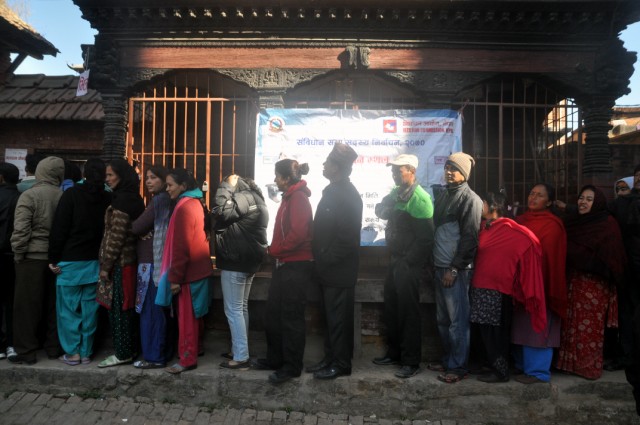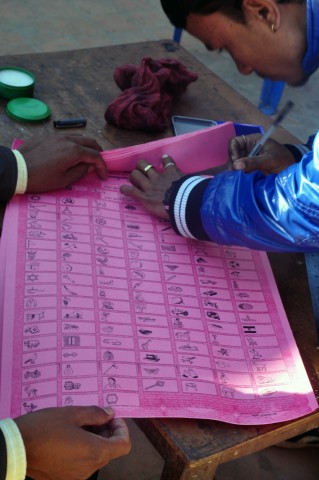
Voters queuing outside a polling station in Kirtipur, Kathmandu, Nepal. Photo by anuj arora. Copyright Demotix (19/11/2013)
Nepal went to the polls today, November 19, 2013, to vote for a second Constituent Assembly, which will be charged with writing the constitution for the nation's governance.
Despite reports [ne] of sporadic incidents of violence and concerted efforts by the dissident Communist Party of Nepal–Maoist (CPN-M) cadres throughout the country to disrupt the election process and implement their call for poll boycott (bandha) during the election period, voters in Nepal were enthusiastic and queued at polling centres in large numbers to cast their votes.
The administration, for its part, tried to ensure tight security on the election day. According to the Chief Election Commissioner (CEC) Nilkantha Uprety, the voter turnout was estimated to be a record 70 percent.

Security personal patrolling Kathmandu city on election day in Nepal. Photo by gagan_thapa thapa. Copyright Demotix (19/11/2013)
Interestingly, there was a lot of participation by women voters, who turned out in large numbers to vote. Kashish Das Shrestha (@kashishds), a Kathmandu- and New York-based journalist, tweeted:
Amazing long lines of #women voters. This one in Kapan (Kathmandu-4). #WomenVote #NepalVotes pic.twitter.com/4mM7w7sD7Y — Kashish Das Shrestha (@kashishds) November 19, 2013
There was also a lot of enthusiasm among the elderly to cast their votes, many of them being septuagenarians and above. One hundred and ten years old Dhan Kumari Gurung cast her vote in Sundaridanda polling centre of Kaski district, while 115-year old Parvati Devi Khadka voted in [ne] the Dadeldhura district.
From Lalitpur, Nepal, research scientist Sameer Mani Dixit (@sameermdixit) tweeted:
Child in arm grandmother brings family to vote ! #nepalispirit #democracy #NepalVotes pic.twitter.com/yfSTKogsS9 — समीरमणि दीक्षित (@sameermdixit) November 19, 2013

An elderly woman being carried by her grandson from a voting centre after casting her vote in the second Constitution Assembly election. Photo by Nabin Baral. Copyright Demotix (19/11/2013)
Throughout the country, not only was the turnout at the polling centres encouraging, but people also expressed happiness in being able to vote and hoped that this election would deliver where the last one failed. The first Constituent Assembly was formed in 2008, two years after a bloody decade-long civil war between the country's Maoists and government came to an end. Nepal's monarchy was abolished shortly afterward, but the assembly failed to write a constitution, and after four years it was dissolved, plunging the diverse country into political crisis.
Nishchal Dhakal (@nishchaldhakal), a doctor based in Kathmandu, tweeted:
Nepal won a lot today. Doubtful looking Elections was a success with the massive turnout. Against the fear and threat we came out. #Proud — Nishchal Dhakal (@nishchaldhakal) November 19, 2013
Sydney Based Nepalese Journalist Rishi Acharya (@rishiacharya) tweeted:
Today Nepal vote for second Constituent Assembly Elections hope this election will institutionalize the republic pic.twitter.com/7jxA3ywIeC — Rishi Acharya ऋषि (@rishiachayra) November 19, 2013
Encouraging number of female candidates
The fate of 6,128 candidates in the First Past the Post (FPTP) and around 10,700 Proportional Representative (PR) categories will be decided today. As reported by nepalvotes.com, 127 political parties are in the fray with 12,147,865 eligible voters. Out of the 6,128 FPTP candidates, 667 -or 10.88 percent- are female, and out of the 10,709 PR candidates, 5,291 candidates are female, reported setopati.com.
AFP Iraq Bureau Chief Prashant Rao (@prashantrao) tweeted an infographic on Nepal's voters:
It's election day in Nepal — follow @AFP‘s @akannampilly and @DeepakAdk for more #FF (graphic via @JohnSaeki) pic.twitter.com/mBlTvpSlBL — Prashant Rao (@prashantrao) November 19, 2013
Confusing symbols
While voters were busy casting their precious votes, they were likely to get confused by the election symbols which are similar if not taken carefully, reported Nepaliheadlines.

Proportional representation ballot paper featuring more than 100 parties. Photo by anuj arora. Copyright Demotix (19/11/2013)
UCPN-Maoist's election symbol is a sickle and hammer inside a circle, while CPN-ML and CPN-United's symbols are sickle and a star, and sickle respectively.
Likewise, Madhesi Janadhikar Forum's election symbol is two hands poised for a Namaste, while Nepal Sadbhawana Party's symbol is a hand and Nepal Shanti Chhetra Parishad's symbol is two hands clapping.
Rashtriya Prajatantra Party Nepal's symbol is a cow. However, Terai Madhes Loktantrik Party's symbol is oxen and the symbol of Janatantrik Terai Madhes Mukti Tigers is oxen with cart.
More confusing are the symbols of Nepal Loktantrik Samajwadi Dal, Janata Party Nepal, Terai Madhes Pahad Himal Ekata Party and Jana Unity Cooperative Party Nepal. They are a pen, a pen and an inkpot, a pencil, and a pen and a copy respectively.
Similar is the case of party symbols of Rashtrawadi Janata Party, Rashtriya Yatharthawadi Party Nepal, Nepal Samabeshi Party and Rashtrawadi Ekata Party. They are a bird, the national bird danfe, a parrot, and a pigeon.
Interesting candidates
While the political parties are competing with each other in the electoral constituencies, the candidates of Bibeksheel Party (Sensible Party) are in the fray along with the political bigwigs in the four major constituencies of Kathmandu. Interestingly, they have selected a dog (Kukur in Nepali) as their election symbol.
According to The Kathmandu Post, “all of the four candidates from Bibeksheel hail from impressive entrepreneurial and educational backgrounds”. It is a tech-savvy group that has been making wide use of social media to engage the people, especially youth. In the past, the Bibeksheel group has played active role in organizing popular social campaigns like Occupy Baluwatar (a peaceful protest movement calling on the Nepali state to better address the widespread problem of impunity and gender-based violence), Entrepreneurs for Nepal, Nepal Unites and Die Banda Die (to end the ‘bandh’ or shutdown culture in Nepal) etc.
For the elections, the one-year-old Bibeksheel party used many innovative campaigning techniques, smileys, rickshaws with flags and of course a lot of social media. There has been a lot of discussion [ne] about this group online, but it remains to be seen if these would have an actual impact on the voters and translated into votes.
Blogger Nepalikukur wrote in the online magazine La.Lit. that voting for the kukur (dog) symbol would be akin to registering a protest vote, but that it could also mark the beginning of a “genuine party of the people”.
Nepalis have given chances to Nepali Congress, CPN-UML and UCPN-Maoist each to rule the country. However, none of them have been successful in satisfying the expectations of general public. This time round, the Nepalis hope to elect a stable government who can draft a constitution and lead the country to prosperity.
Now begins the wait for the winners and, more importantly, the constitution.







2 comments